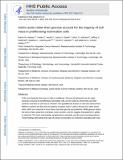Amino Acids Rather than Glucose Account for the Majority of Cell Mass in Proliferating Mammalian Cells
Author(s)
Johnson, Marc O.; Rathmell, Jeffrey C.; Steinhauser, Matthew L.; Hosios, Aaron Marc; Hecht, Vivian Chaya; Danai, Laura V; Manalis, Scott R; Vander Heiden, Matthew G.; ... Show more Show less
Downloadnihms760116.pdf (1.599Mb)
PUBLISHER_CC
Publisher with Creative Commons License
Creative Commons Attribution
Terms of use
Metadata
Show full item recordAbstract
Cells must duplicate their mass in order to proliferate. Glucose and glutamine are the major nutrients consumed by proliferating mammalian cells, but the extent to which these and other nutrients contribute to cell mass is unknown. We quantified the fraction of cell mass derived from different nutrients and found that the majority of carbon mass in cells is derived from other amino acids, which are consumed at much lower rates than glucose and glutamine. While glucose carbon has diverse fates, glutamine contributes most to protein, suggesting that glutamine's ability to replenish tricarboxylic acid cycle intermediates (anaplerosis) is primarily used for amino acid biosynthesis. These findings demonstrate that rates of nutrient consumption are indirectly associated with mass accumulation and suggest that high rates of glucose and glutamine consumption support rapid cell proliferation beyond providing carbon for biosynthesis.
Date issued
2016-03Department
Massachusetts Institute of Technology. Department of Biological Engineering; Massachusetts Institute of Technology. Department of Biology; Koch Institute for Integrative Cancer Research at MITJournal
Developmental Cell
Publisher
Elsevier BV
Citation
Hosios, Aaron M. et al. “Amino Acids Rather Than Glucose Account for the Majority of Cell Mass in Proliferating Mammalian Cells.” Developmental Cell 36, 5 (March 2016): 540–549 © 2016 Elsevier Inc
Version: Author's final manuscript
ISSN
1534-5807
1878-1551